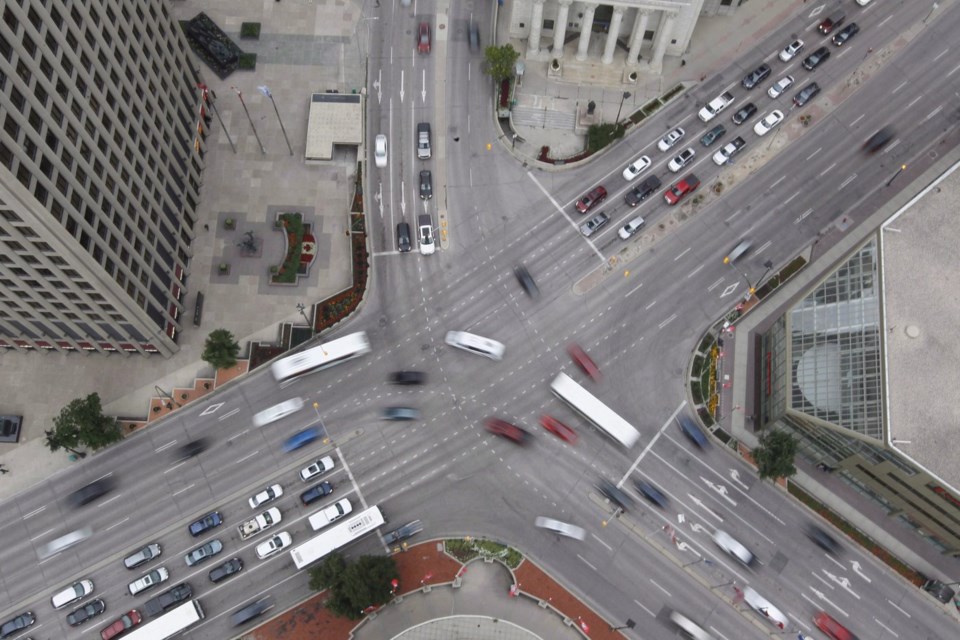WINNIPEG — About 100 residents, including horn honkers, sign-wavers and dog walkers, descended upon a famed Winnipeg intersection Friday to legally cross the street in more than four decades.
Long gone are the slabs of concrete barriers that blocked pedestrians for 46 years from crossing the Portage Avenue and Main Street intersection in what is considered one of the city's windiest corners. New traffic signals, curbs, sidewalks and transit stops now pepper the area.
"Today marks a historic moment of its own. We're officially reopening Portage and Main to pedestrian traffic," Mayor Scott Gillingham told the crowd.
"Today we're putting an end to 46 years of debating whether or not people should be allowed to cross the street."
Gillingham was joined by city council members and an accessibility advocate as he took a ceremonial first stroll at one of the crosswalks while "Prairie Town" by Winnipeg-born Randy Bachman played on large speakers.
"Winter nights are long, summer days are gone. Portage and Main, 50 below," sang Bachman, in what is likely the most famous tune referencing the landmark intersection.
The crossroads hold a special place in Winnipeggers’ hearts.
It's where the city's first business was set up outside a fort to the south, becoming the centre of Winnipeg as it grew to become the gateway to the West.
It was open to pedestrians until 1979, when developers agreed to build an adjacent office tower and underground mall on the condition the city force pedestrians below street level.
Ever since, large concrete barriers have prevented people from crossing, guiding them to an underground circular concourse that can leave visitors confused. Its series of hidden, narrow stairway entrances and not-always-functional elevators have also raised concerns about accessibility for those with mobility issues.
The intersection has also been a place where people have congregated by the thousands to celebrate milestones and protest social injustices.
Lyndsey Wallis came to the opening ceremony with a friend and their two bikes.
"It's always been a pain in the butt to cross the road. It's been scary to walk underground especially outside of office hours, and I am just really excited to have a more accessible downtown," said Wallis, whose apartment overlooks the intersection.
Martina Kucey, along with her dogs Carter and Bishop, were part of a crowd that started to form more than an hour before the crosswalks officially opened. Kucey joked her two furry companions wanted to be the first dogs to walk across the reopened intersection.
She has been living in Winnipeg since 1981 when she moved from Europe and said she has frequently fielded questions from friends and family who visit about why pedestrians had to go underground to cross the road.
"It feels like we're going back to what it should have always been," she said.
Opening up the landmark intersection had long been debated. In 2018, two-thirds of residents who voted in a non-binding plebiscite called for the barriers to remain.
That changed last year when a study found that carrying out repairs at the intersection while maintaining the underground walkway would cost $73 million and disrupt traffic for years. City council then voted to open up the junction.
Holding a green sign with the word "Finally" written in black marker, Janet Wiatrowski called it an important step in uniting Winnipeggers. "The drivers will cope with it, the pedestrians will cope with it and learn that it's a spot for everybody, not just cars and buses."
Critics have argued the barriers should be kept to reduce accidents and traffic snarls. Some also worry about the closure of local businesses in the underground concourse, known as the "circus."
A woman waved a sign that said "Still brewing one level down @ Empty Cup" at the crosswalk while employees of the local coffee shop handed out free samples.
Gillingham said the concourse isn't closing in the near future as council is waiting on a city report to determine whether they need to do a full or partial closure.
"Reopening this intersection isn't a silver bullet,” he added.
“But it's important for the progress that we are making, step by step, block by block, to build a downtown for everyone."
This report by The Canadian Press was first published June 27, 2025.
Brittany Hobson, The Canadian Press



